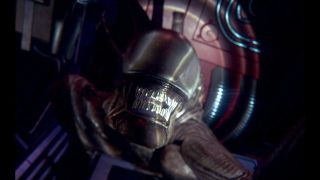The news of an Alien: Isolation sequel is excellent for fans of the wider Alien franchise, the first game, the best horror games, and for those who appreciate the art of videogames themselves.
For me, however, I’m conflicted. I’m simultaneously really looking forward to it, but also scared of the prospect of an even cleverer and scarier upgraded Xenomorph chasing me down another exquisitely designed spaceship.
I know, ‘Player finds known scary horror game to be scary’ isn’t a new concept but this, combined with a sincere and deep appreciation for environmental design and the way that Creative Assembly infused the Sevastopol ship with faithful, detailed representation of the source material means I’m put in an interesting position for the sequel.
In short, Alien: Isolation is so well made, designed, and executed but it can often be so paralytically scary. If the sequel follows suit, then I might be in a difficult spot that sees me balancing the desire to explore a breathtakingly detailed ship (or planet?) that’s full of a sense of place and excellence in environmental design against, well, sheer and utter terror, and tension and suspense so thick you can almost touch them.
Hiding away

I picked up the first game in 2017, three years after it came out, after hearing some Alien-fanatics speak once again about how good it recommend it incredibly highly. I knew it was a super-tense survival horror game, of course, but always love video game interpretations of movies and other media (and vice versa, for the record).
I’m not a huge horror fan by any means (in any media) but my aforementioned appreciation for environments, a sense of place, and the craft of placemaking have always helped me dip my toe in the genre – particularly in games like Dead Space and Alien: Isolation. As a result, I vividly remember spending hours examining the retro-futuristic details and tech close-ups, taking screenshots of the signage and materials, and combing through archive logs to immerse myself in the Sevastopol’s ambiance and environment.
But then there was the Xenomorph. The brilliant, horrifying, and incredibly clever Xenomorph. This enemy is one of the scariest I have encountered in games, and made the terror, suspense, and tension in Isolation. After the first encounter with the Alien, even the bits without its presence were terrifying – in an anticipatory, unseen-terror way.
Alien: Isolation’s Xenomorph runs the line between a chilling foe and a video game ‘baddy’ that’s too powerful and the perfect, thought-provoking tension-building stalker beautifully. Its mix of slow deliberate movements and rapid scuttling and sprinting, the Giger-inspired form, and its perfect build as a ruthless killer, make it a perfect enemy – and one that you can only avoid; it’s too powerful to take on and defeat.
Throw in the fact that even the tools you have to navigate the ships and locate and evade the alien can turn on you – the motion detector can give away your position due to its volume, for example – and the fact it ‘learns’ the way you play and can even use noise detection through the microphone in your controller to locate you, and your journey as Ripley through the Sevastopol is a sweat-inducing stressful affair, to say the least. I for sure did not need the extra stress of the Xenomorph learning my cowardly ways to track me down quicker or use my panicked yelps to murder me sooner.
Such was the result of this terror, at one point, my Ripley was in a cupboard for a good couple of weeks. It was the safest spot for her, honestly. Let the Alien roam the Sevastapol at its leisure, and Ripley can stay safe in this desk cupboard. Simple.
Then, even after eventually returning and finishing the game, I just had to get it out of my house, and it’s probably my record trade-in post-completion of a game ever. I have not had any inclination to play it again, and do not want to feel that kind of stress or tension ever again when playing a game.
The light at the end of the tunnels

What did drag me through the game, however, was indeed the Sevastopol as a horror game setting and the sense of place it achieved through authenticity, detail, and place-making. attention to detail that the game has so richly received credit for over the past 10 years. There’s a reason the game’s attention to detail is still being praised, a full decade after it came out; an entire book recently came out dedicated to it.
I’m deeply invested and interested in the design of game environments, so fell back on that – and a compunction to finally outwit and see off the Xenomorph – to push on and endure the terror and tension. It’s a fine example of a game’s environmental class and detail being almost the sole thing that ensured I finished the game; to see it all and drink it all in.
The craft of the environments goes beyond a basic recognition factor or enjoyable spotting of details that folks might remember from the film series too; it’s a functional retro-futuristic sci-fi that you can relate to and imagine using rather than something that’s wild and fantastical; everything is made to a relatable human scale, and spaces and rooms are designed and arranged accordingly too.
This contrast between a superb sense of place just about offset the terror in the first game, but such is the acuteness of the latter, I really hope the sequel can be navigated in a similar (cowardly) way.
Thus, herein lies my current ‘predicament’: I already really want to play the sequel, but I do wonder if I’ll have to ensure my character takes elongated breaks in cupboards again to get through it.
You might also like
Services Marketplace – Listings, Bookings & Reviews
